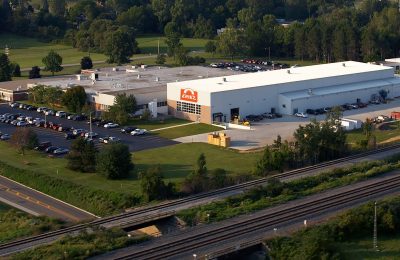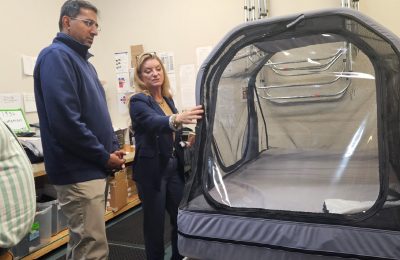Area Employers Shed Light on What May Be Ahead
Facing higher inflation and rising interest rates, experts have indicated that economic growth is expected to decelerate, suggesting a recession is just around the bend.
But how mild or severe it may be remains uncertain, given the resilience of other market trends.
“One sign that the national economy remains fairly robust is the tight labor market, as reflected by the low unemployment rate and continued job growth, and this is certainly a reason for cautious optimism,” explains Ken Louie, Ph.D., director of the Economic Research Institute of Erie (ERIE) at Penn State Behrend. “However, consumer spending, which is a major driver of the economy, has been slowing down recently.”
In fact, recent data suggests that household savings, which were accumulated during the pandemic are now declining, which may further dampen consumer spending. “Expenditure trends experienced by small businesses in the upcoming Christmas shopping season may provide additional clues as to whether the cautious optimism will persist into 2023,” says Louie.
One of the best gauges to get a pulse on the economy is from area employers representing different industries, including banking, health care, education, logistics/ transportation and manufacturing.
Banking and Finance
“The Fed has stated its intent to continue to raise interest rates — which makes the cost of borrowing more expensive — as a strategy for bringing down the rate of inflation. As a result,” states Anita M. Kuchcinski, senior vice president, Erie Commercial Market executive for Northwest Bank, headquartered in Warren, PA, “we anticipate a slowdown in borrowing among consumers and businesses due to rising Fed interest rates. Other impacts to consumers that are likely in 2023 as a result of inflation and associated rising expenses include a decrease in personal liquidity and an increase in unsecured debt. It’s important to keep in mind that inflation will eventually decline with Fed action and the idea that one of the best cures for inflation is inflation.”
“In addition to the impact of inflation,” Kuchcinski adds, “2023 will see a continuation of the digital transformation in the banking industry as banks place greater reliance and emphasis on digital platforms. The trend of consumers moving toward online banking and other digital solutions grew during the global pandemic and will increase in the year ahead.”
According to Kuchcinski, the business outlook for Northwest Bank in 2023 is strong as it continues proactively adjusting to the changing times and economic challenges described above. Examples of how Northwest plans to do that include rolling out additional digital platforms in response to ongoing customer interest in these technologies, focusing on growth and diversification of its commercial banking business, and expanding product offerings as it grows.
In Kuchcinski’s opinion, one of the most significant challenges for the banking industry in 2023 is the same one that will continue to affect practically every industry: employee recruitment and retention. “At Northwest Bank, finding, hiring and keeping great employees will remain a primary goal in the year ahead. We’ve developed a number of strategies to intentionally support that effort and create new opportunities for our people, including the introduction of employee resource groups (ERG) recently. ERGs bring together people with a common identity to share experiences, foster engagement, and otherwise contribute to an inclusive, positive work experience.”
Health Care
Health care too had to re-adjust and adapt. According to Allen Bonace, president and chief executive officer of Saint Mary’s Home of Erie, “the health-care industry is still responding to the COVID-19 crisis, but the dynamics are beginning to shift in a way that allows the industry to re-focus on growth and innovation to ensure that we are providing the best care possible and meeting the needs of those we serve.”
“In particular, “ he continues, “the long-term care and senior living sector is doing this by preparing for the continued aging of the Baby Boomer generation as demand for services is expected to grow.”
For Saint Mary’s Home of Erie, Bonace believes the outlook is promising. “We have focused our energies on the continuous enhancement of our Asbury Ridge campus. By investing in construction and renovation projects that will improve services offered, we’re taking steps to better meet the lifestyle needs of seniors today and in the future. One of the reasons Saint Mary’s still exists 140 years since our founding is because we adapt, and will continue to adapt, as we head into 2023 and beyond.”
Still, challenges do exist, especially when it comes to the workforce. “Health-care workers are facing burnout and quitting or retiring faster than replacement rates. It requires action on a lot of fronts,” says Bonace. “Having a talented, engaged and diverse workforce is vital for providing high quality care to our residents and for the well-being of our team.”
That’s a major challenge for those in other areas of the service sector as well. According to the U.S. Bureau of Labor Statistics, employment growth over the next 10 years is expected to be highest in service industries such as health care and social assistance; leisure and hospitality; and educational services.
Education
Yet, according to Angela Burrows, associate vice president (AVP) and chief marketing officer of the newly integrated PennWest University (California, Clarion and Edinboro universities,) higher education has faced a number of headwinds in recent years due to challenging demographics, cost and public skepticism. “The pandemic exacerbated some of these challenges,
but also paved the way for new approaches to course delivery and program offerings,” she says. “At PennWest, we’re all about agility and finding ways to meet the evolving needs of students and employers.”
For instance, at PennWest’s newly integrated university, “We had a nearly 2-percent increase in first-year student enrollment this year, which is an indication that awareness of PennWest is beginning to take hold and students are confident about the university’s future,” says Burrows. ”We have heard from students who already are reaping the benefits of living on one campus and taking advantage of course offerings on the other two.”
And online offerings also added to its curriculum. “Our Global Online division provides even more opportunity, especially for those who are balancing pursuit of a degree or a certificate with other responsibilities,” says Burrows.
To stay ahead, “we will have to continue to demonstrate our value to students who are wise consumers,” states Burrows. “That is not so much a challenge for us, but an opportunity to tell the story of all of what we have to offer as the second largest public university in Western Pennsylvania.”
Manufacturing
According to Louie, industries expected to face challenges in terms of job growth include manufacturing, retail trade and the government sector. These national trends are broadly similar to what researchers have seen in the local economy in recent years.
However, Louie points out that one silver lining is that the manufacturing sector is still fairly strong in terms of its output, both nationally and locally, despite the employment challenges. Nationally, manufacturing output is expected to grow over the next few years. Locally, manufacturing accounts
At MFG Tray, an industry leading composite manufacturer, the Linesville, PA-based company is cautiously positive about the next fiscal year. “Suppressed demand driven by supply chain issues of 2022 are driving this growth short term,” explains John Thompson, MFG Tray’s president and general manager. “The duration of this short-term experience is targeted to be enhanced by new product introduction to our existing markets.”
Thompson sees opportunities in new product introduction for MFG Tray’s confectionery market, product acquisition increasing the company’s offerings for its industrial market, and new product introduction in food service and pharmaceutical markets. Challenges include raw material pricing stabilization and other supply chain inflation factors, labor market shortages and utilities’ inflation.
“Supply chain stabilization is our biggest challenge for 2023,” says Thompson. “If we continue to successfully navigate this challenge to the level of 2022, our business will continue to be strong.”
Logistics/Transportation
Logistics/transportation is also one of the best indicators of a strong economy, and for Logistics Plus (LP), headquartered in Erie, the outlook for 2023 means “full speed ahead,” according to Founder and CEO Jim Berlin.
“We’re not a crystal ball here, but most experts following transportation and logistics believe the economy will see some contraction in Q1 and Q2, and then a return to modest growth the remainder of the year,” adds Scott Frederick, LP’s chief marketing officer. “Hopefully, that means transportation capacity will be more widely available and rates will hold steady. We still have some headwinds due to lack of truck drivers, high expense of operating trucks/fleets, new safety and labor regulations, carbon emission guideline updates, reductions of ocean sailings and air flights, extremely tight warehousing capacity and more.
“And that’s assuming we don’t have any more events that disrupt supply chains, like hurricanes, droughts, and wars,” Scott continues. “We view the slower first half of 2023 as a great time to enhance collaboration with your 3PL and/or carrier partners, consider investing in TMS technology if you haven’t already, and re-segmenting your business to better determine how best to cover it through dedicated, contract or spot market activities.”
Frederick says LP continues to see great opportunities to expand its services with both current MBA members across the region, and with non- MBA members around the world.
“Challenges continue to be helping our customers find affordable transpor- tation capacity amid a myriad of weather, economic and geopolitical supply chain disruptions,” he says. “However, we have cultivated a great workplace with over 1,000 talented and caring professionals around the world using cutting-edge technologies; so, we feel our CEO’s goal of ‘humbly conquering the world from Erie, Pennsylvania’ is still something we can aspire to.”
According to Louie, a key trend to watch is the degree to which Erie can sustain all the positive economic development initiatives that have been taken across the region over the past several years. “Many of these initiatives have been the result of broad collaborative efforts across our community,” notes Louie. “If we can sustain the momentum to move Erie (and PA for that matter) continuously in a positive economic direction, we are likely to see a much more prosperous and dynamic regional economy in the years ahead.”
To learn more about what’s in store for the economy in 2023, register for the MBA’s Economic Outlook IMPACT Luncheon, starting at noon December 8 at the MBA Conference Center in Erie at mbausa.org.













